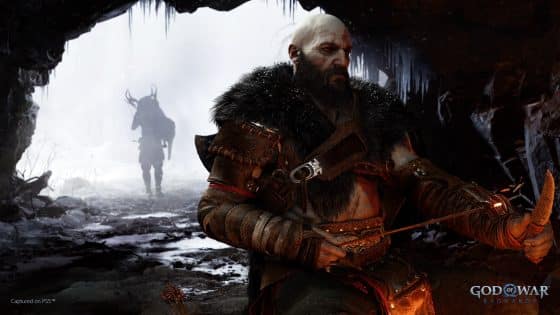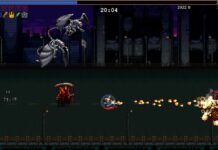The new God of War has been out for a hot minute and it’s time for us to talk a little about action combat systems!
The Devil’s in the Detail
I don’t even know how to start this without laying down some massive prefaces. As I mentioned in my review, God of War Ragnarök’s combat system is fine. In some situations, it’s really great when it starts playing to its strengths. But I mainly felt that it didn’t live up to its full potential. And in that same review, I mentioned Devil May Cry 3 a lot. As one should do since Devil May Cry 3 happens to be one of the most important action games ever made. And while I’m a massive Itsuno fanboy, that doesn’t mean I want Kratos to go back to jumping 20 feet into the air to send his enemies into the Shadowrealm.
Instead, I want this to be a healthy discussion about what I value in action combat systems while also explaining what I think is a problem with God of War and in fact many other recent action titles. For comparison, if you want to see God of War’s brand of action combat be taken to the max. I highly recommend checking out the recently released Evil West. It’s a little rough around the edges but it does get a lot right.
So let’s talk about Devil May Cry 3 for a hot second because I’m gonna reference it a lot going forward. The title was released in 2005 and still holds up today, there was even a recent Switch port of the title that expanded on the games already amazing combat even more. I can jolt it down to a few things, consistency, versatility, enemy design, bosses, and responsiveness. Now I want you to bear with me here while I try not to sound overly pretentious and opinionated.
The Action Game Genre vs The Spectacle Fighter
Before we can even get into the nitty-gritty of this we gotta put down some genre definitions. A while ago the term Spectacle Fighter cropped up to define titles that focus on dispersing enemies with as much style as possible. This brings up this conversation: Is it fair to compare a God of War Ragnarök to something like Bayonetta 3? Of course not. Despite both wearing the fancy hat of an action game with melee combat, their focus lies in different aspects of their design. But, having a combat system with the depth of Mariana Trench does not mean those types of games don’t share common elements and design kinks that should apply to both.
I believe that the distinction that makes a Spectacle Fighter what it is, is depth. It’s why those kinds of games look more like fighting games than your traditional beat’em up. So if we compare combat gameplay videos of God of War Ragnarök for example with Devil May Cry we’ll observe the glaring difference. If you see a video that is all about God of War’s combat, chances are they tend to involve someone cycling through all their abilities in order to make it look way more flashy than it is.
If you play the game, chances are most of you will use the Leviathan Axe in one on one combat, spamming the light attack when your abilities are on cooldown and charging up the heavy attack when you have some breathing room. If there are multiple enemies you use the Blades of Chaos in a similar fashion. The reason for this is that there is no real incentive to make use of your whole arsenal all the time. The game doesn’t actively encourage you to mess around and find out. Stack on top of that buff timer that encourages you to dump all your abilities in a small time window and you get a modern God of War.
This is not bad gameplay, don’t get me wrong. But I never felt like I need to switch up my strategy or adapt to enemy types outside of the occasional boss fight. Of course, I can’t speak for everyone but I would assume that most players will go through the game playing like that. And thanks to probably rigorous playtesting, the game will allow players to do this with little to no friction. Because obviously, the combat is now why most would play God of War Ragnarök, right?
But the solution to this is surprisingly simple. In Devil May Cry 3, you can go through the entire game only using two weapons and some of their attacks. The average Devil May Cry 3 playthrough, actually that goes for the entire series, has players regularly perform impromptu dance routines that can vary significantly from player to player or even playthrough to playthrough. The reason for that is the Style Gauge, which is probably the best thing coming out of the Devil May Cry franchise.
The Style Gauge judges your performance while fighting enemies it is constantly on your screen while not actually affecting gameplay at all. It is mainly affected by a few things: If you’re hit by an enemy, how close your dodge was, taunts, and the number of unique moves used. See your Style Gauge rating will go down if you repeat the same combinations over and over again. The game doesn’t punish you, but it’s this subtle encouragement that gets players to experiment and use more of their arsenal instead of your bread-and-butter combinations.
Enemy Design
Great enemy design is where a good action game lives or dies. And to their credit, God of War Ragnarök and a lot of other recent action titles like Horizon Forbidden West have exceeded at delivering all kinds of visual treats for you to fight. But we’re going to focus a bit on the design on a more technical level, animations, and all that.
It’s something I notice in a lot of titles of late, especially the Soulsborne titles have been guilty of this. You fight a lot of human-type enemies. This makes sense; they tend to make for more interesting encounters than hideous blob monsters. And you want to save all the actual cool monsters for your boss fights.
However, if you encounter enemies in games, they tend to come in four flavors. Normal type that uses weapons similar to you, the big heavy ones with long charge-up animations that deal loads of damage, the one that attacks from a range with some kind of status effect like poison, and the fast one. These tend to be the standard enemies you’ll encounter sometimes, there is a mix between the types to switch things up.
I only get really cross with this once I realize non of them require any special strategy to be beaten. You fight them all the same outside of learning some patterns or whatever, that’s boring. Since Dark Souls became popular, people tend to get really cross with gimmicks in enemy design. I love it, give me birds I have to shoot down with ranged attacks first or a really quick enemy that I have to land a counter on first. Anything but the same.
And for me, this gets especially egregious when a game has 20 different enemy types, but they are actually the four I mentioned above with a different coat of paint. Slapping wings on a ranged fighter or giving a heavy one a fast teleport doesn’t make them more interesting to fight. It just adds more stuff for the player to deal with.
Give me 7 well-designed enemies that you can pair off with each other who are fun to fight on their own. And don’t give me like 50 enemies who might look visually distinct from one another but practically function the same way.
The Boss Fight
The boss fight is very important, those tend to be the ones that stick with players long after they rolled credits. So raise your hand if you have fought the following: Big monsters with a huge spectacle around them with large attacks that cover most of the fighting arena. Now, wait until they’re done with their attack or you did a thing like a throw something at them so you’re allowed to actually do damage to that big health bar.
I have just described what might be the most boss fights in action titles of the past ten years. While there is nothing wrong with that design, it doesn’t really feel like you’re fighting the boss. You’re just waiting to empty a health bar half the time while soaking in the atmosphere. And for the spectacle, it’s okay, but I don’t think it makes a good boss fight.
To me, a good boss fight is something or someone you actually fight against. There is a constant back and forth instead of lots of waiting and doing things that are not fighting the boss. Now, look at something like Monster Hunter. For example, you’re fighting a creature that attacks and defends itself. Maybe it’s aggressive, or maybe it just wants to get rid of you and flee.
Bosses are also great ways to get personalities across and while giant hulking monsters don’t tend to have personalities outside of wanting you dead. There is still lots of ground to discover here. The RPG genre is full of boss fights with unique little things, exposing a weakness if the player tries to find it out and gather the materials. Or at least make it more than learning the attack patterns and getting the timing for the parry down.
Visuals Fidelity Overload
As games become more realistic in terms of graphics, it’s getting really hard to overlook the more video-gamey aspects of it. Having your character skip from one animation into another doesn’t look that glaring in a 2D fighting game sprite. But it looks odd to have limbs snap into place on a fully 3D-scanned model with billions of polygons. It’s just that with a vast amount of visual polish, we also tend to sacrifice tiny little things.
Here is my big pet peeve. I don’t like how in many modern games, animations tend to magnetize player characters and NPCs to each other. It looks cool that your punch will connect as long as you’re in range and will always hit that one spot on an enemy’s chin. Looks great but the system isn’t flawless either and messes with consistency. See, sometimes enemies will attack you and be a few degrees off. So I think, having played lots of other video games and having been punched in real life, they’ll miss me. But half the time, they will awkwardly turn into position to still hit you or scoot closer.
The problem here is just that it’ll be super inconsistent half the time. The attack will hit me, or it won’t. This goes both ways by the way and especially in a game like God of War, this is a problem because positioning can be very important. You already have so much forward momentum by attacking anyways but you’ll more and more expose yourself to more and more enemies.
And something that gets lost in all the pretty graphics of new camera perspectives is clear tells. This might be my opinion, but if you need a big colored circle or dot to indicate that an attack is unparryable or requires special input, I think you failed on the most basic level. This transitions into a larger point in a bit but just flashing something or slowing everything down is not exactly elegant because this becomes a problem when there are several enemies on the screen and suddenly, the game becomes hard to read.
There is so much we can with animations or the visual language of design to indicate those things. I’m not sure if having players learn which attacks can be parried or blocked and which not is a solution. Personally, I always feel that player skill should be rewarded, so why don’t make every attack parryable from the start? It adds just loads more depth to the combat because players will now have to choose between the safe and the risky option.
Consistency in Combat
This leads us to my final point and my biggest complaint about almost every game ever. Consistent rules in its systems. For example, if the game teaches me that I can block attacks, I will automatically assume that it works for almost everything, right? Now imagine there is a magical projectile that I can’t block. It comes out of nowhere and will leave me baffled for a moment. That’s an extreme case.
To me, this applies primarily to stuff like invincibility frames (the few moments within an animation you can’t be hurt in). Again, God of War Ragnarök. The number of times I’ve been hit mid-animation was astounding. Now some of you might say that is a skill issue, which sometimes was the case. But God of War Ragnarök’s special abilities has special cast/charge animations. Sometimes you’re invincible during them, sometimes you take damage, and sometimes you’re hit out of them for no reason. After some experimentation, I still can’t tell you the rules.
The same goes for enemies as well, some charge their big unblockable attack and you can just hit them out of it with a heavy attack. Sometimes they’ll get staggered and sometimes, they will just ignore you. This is not just inconsistent between enemy types. This is inconsistent within the same attack animation. The rules aren’t clear and it isn’t very clear. Often this would get me to play way more conservatively or not use my special abilities at all because they are not worth the risk of getting smacked in the head.
You can say this comes under the guise of risk-reward gameplay, but often it doesn’t feel fair. I could also go on about how two enemies will sometimes attack you at the same time with the first attack being parried while the second one will still hit you. It doesn’t feel fair.
And it’s not just God of War that does this, most action games I’ve played this past year do this. Even the damn notorious Soulsborne franchise is littered with these inconsistencies that drive me up the wall. But I wouldn’t be upset about any of this if other games hadn’t found solutions to this already or just cared a lot more about these tiny little details.
Holding Action Games to Higher Standards
These are problems that plague the entire genre of action games and most of its sub-genres. While I don’t think every game should be on the level of Devil May Cry or Kingdom Hearts (The series with easily the greatest boss fights in all of gaming), I think those are the standards we should other action titles to. You can have a different focus and all the fancy things and graphics. But if most of your game is still focused on combat, I believe you owe it to your audience that it stays entertaining and fair throughout the entire playthrough.
Because I’m starting to get the feeling that many of these titles just want to tell a story but feel obligated to throw in combat every few minutes to keep the player engaged. But most of the time, I’m sure loads of players want to get past that combat to get more of that story you’re telling. Fighting in those games should never feel like an obligation and to do that, these systems have to be rich enough to stay entertaining long after the player has rolled the credits, at least from my perspective. Also, play God Hand, please.
For more nonsense, please consider giving us a visit here on ESTNN
estnn.com











